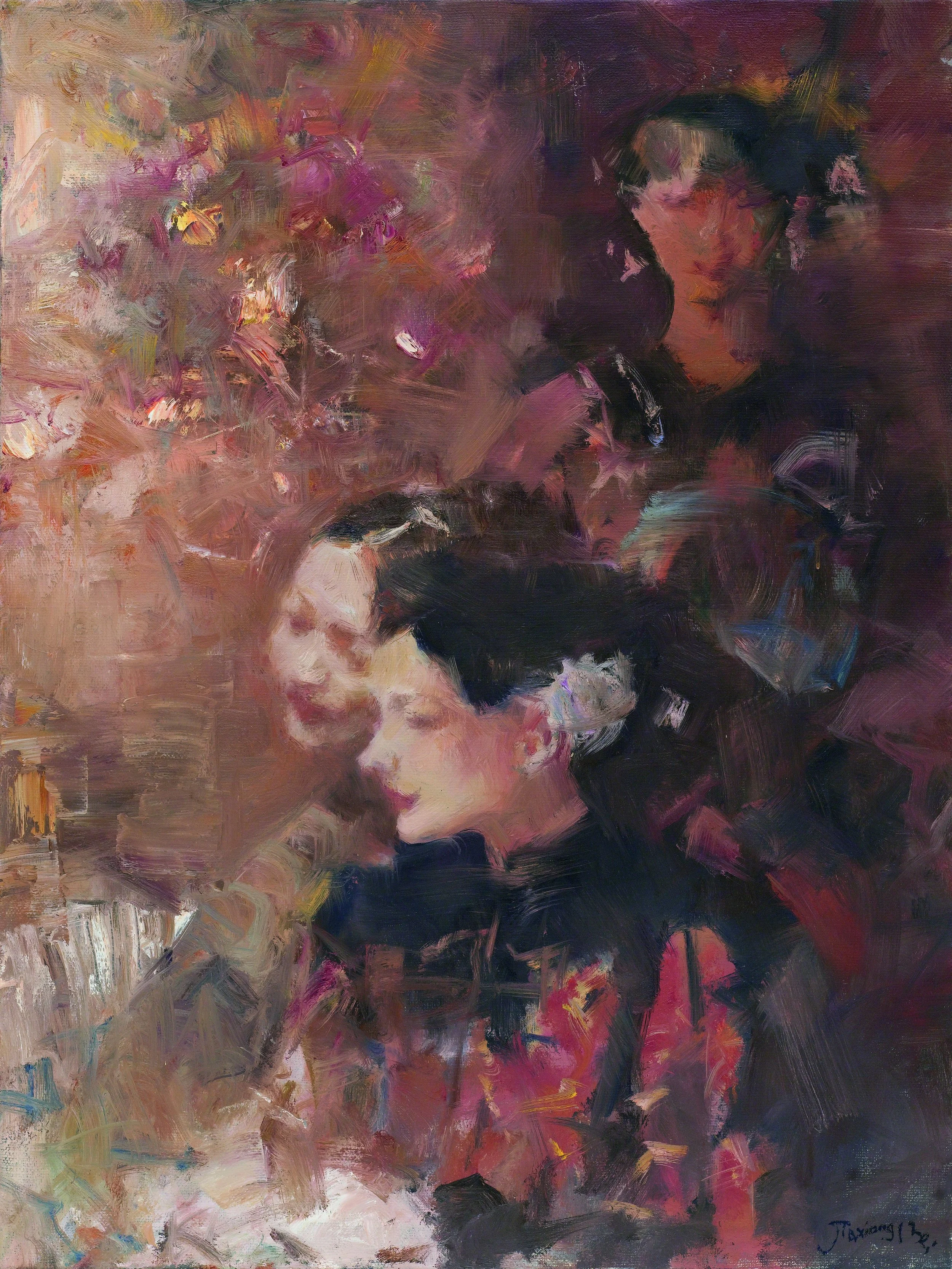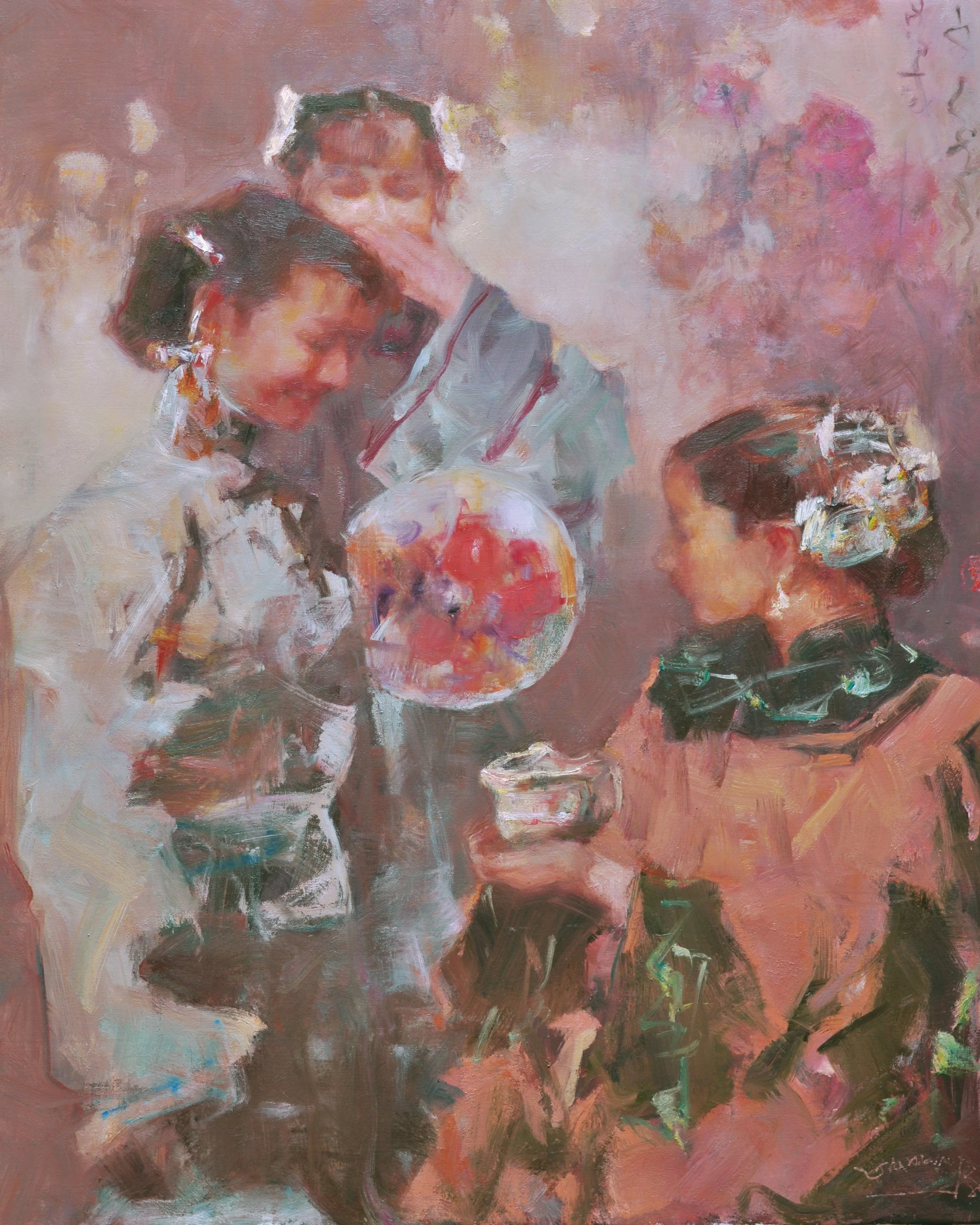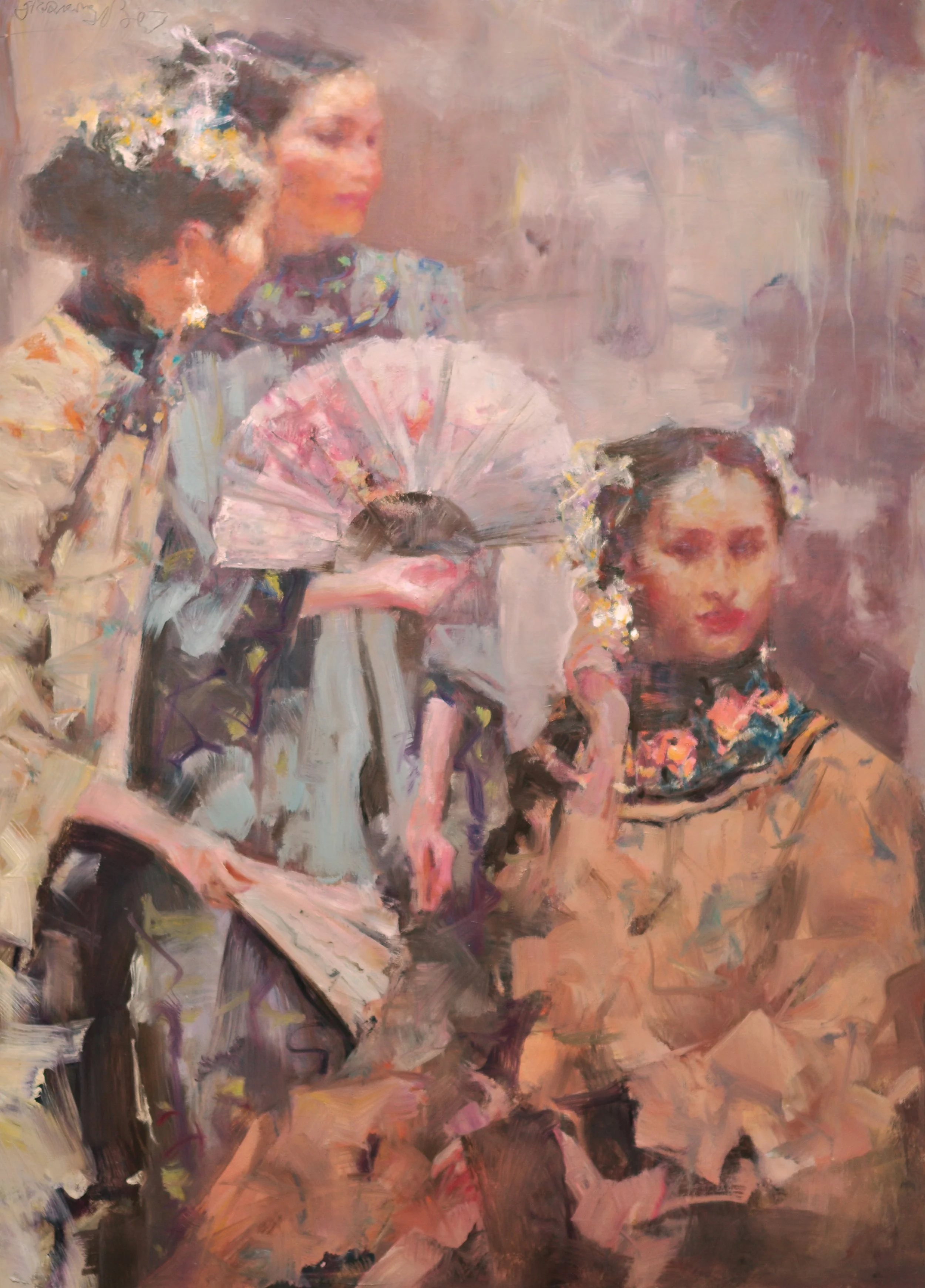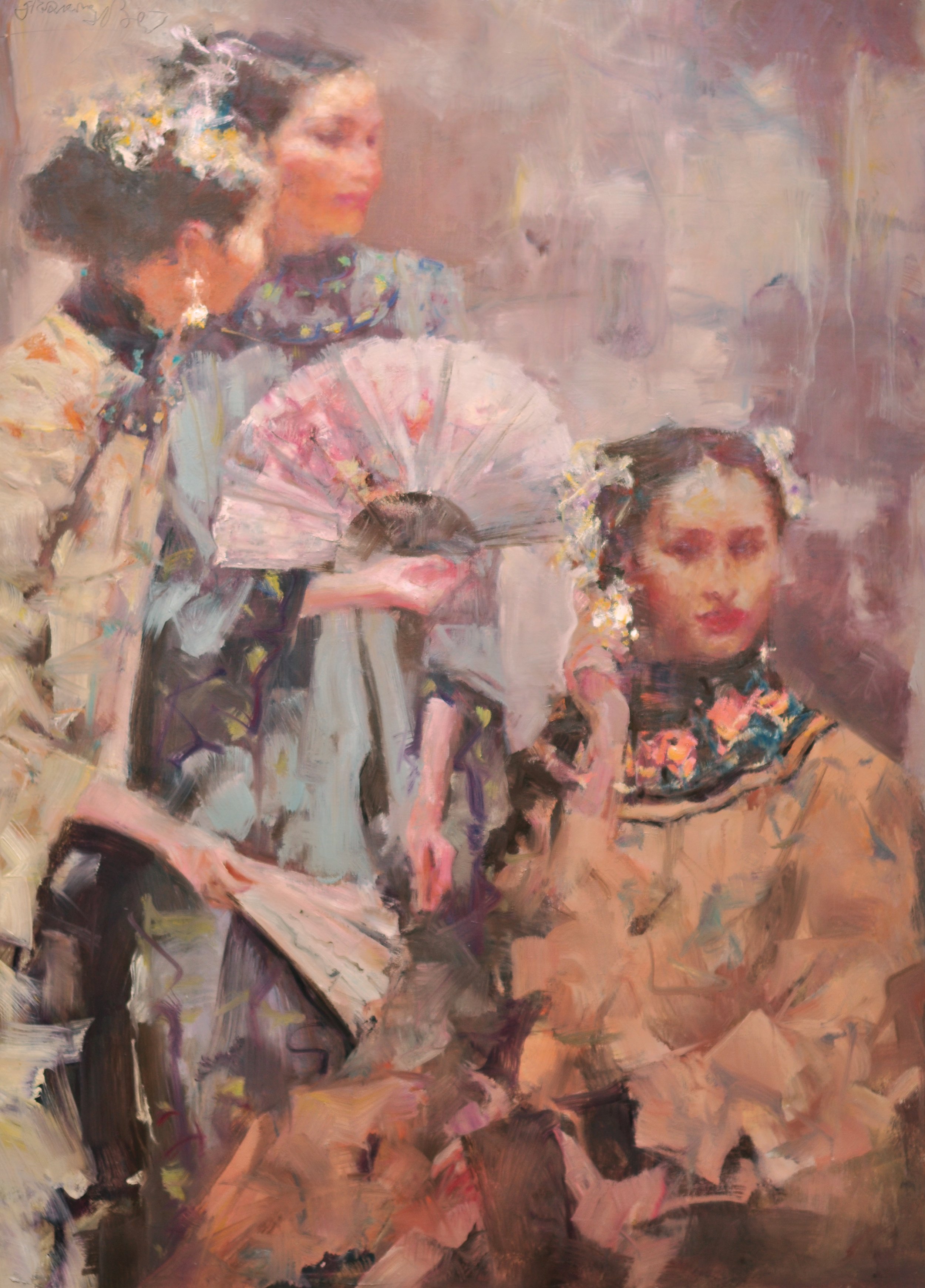
The grace of flowing water, the bone of a rock—gentle while resilient.
This is the Oriental Demeanour.
“Beauty is an eternal delight, ever-changing in form.”
— Eugène Delacroix
-

Shanghai Dialect I - Lark (Collected)
Oil on Canvas
108×153 cm
2016
-

Shanghai Dialect I - Oriental Rouge
Oil on Canvas
108×153 cm
2016
-

Shanghai Dialect I - Sunglow
Oil on Canvas
108×153 cm
2016
-

Shanghai Dialect I - Moss
Oil on Canvas
108×153 cm
2016
-

Shanghai Dialect I - Lilac Frost
Oil on Canvas
108×153 cm
2016
-

Bond
Oil on Canvas
80×100 cm
2015
-

the Vermillion Trio
Oil on Canvas
80×100 cm
2015
-

the Unseen Stir
Oil on Canvas
129×172 cm
2015
-

Days Gone By (Collected)
Oil on Canvas
80×100 cm
2015
-
To Share (Collected)
Oil on Canvas
80×100 cm
2015
-

the Svelte Pair
Oil on Canvas
80×100 cm
2015
-

Tangled Thoughts (Collected)
Oil on Canvas
98×138 cm
2015
-
Reserved Grace (Collected)
Oil on Canvas
98×138 cm
2014
-

Lantern Festival
Oil on Canvas
150×153 cm
2015
-

Shanghai Dialect II - Sway (Collected)
Oil on Canvas
74×95 cm
2017
-

Shanghai Dialect II - Lithe Grace (Collected)
Oil on Canvas
74×95 cm
2017
-

Shanghai Dialect II - Demure (Collected)
Oil on Canvas
73×91 cm
2017
-

Shanghai Dialect II - Willowy
Oil on Canvas
73×91 cm
2017
-

Shanghai Dialect II - Curvy Elegant
Oil on Canvas
73×91 cm
2017
-

Shanghai Dialect II - Radiance
Oil on Canvas
73×91 cm
2017
-

Shanghai Dialect II - Sotto Voce
Oil on Canvas
73×91 cm
2017

Artwork Interpretation
The Old Time of China…
BEI Jiaxiang’s Chinese Ladies series sails into the confluence of Eastern and Western aesthetics as a boat.
In the work of Flores Aurantii, several sharp and swift brushstrokes cut through the warm ochre and ivory white colour fields, blending into a refined composition with angular edges amid harmony. Yet in Tea Time, a circular fan frame encloses the centre of the picture, guiding the viewer’s gaze along the gradient of cyan-grey and crimson, as if ink wash naturally spreads on xuan paper. These fan shapes are no longer merely structural components; they divide space, guide vision, and become a silent dialogue between the traditional literati’s wisdom of space arrangement and Western abstract composition principles.
Meanwhile, the content of the fan transforms into a spiritual carrier bearing cultural memories. BEI uses oil paint to simulate the breath of ink wash: in Illusion, thin layers of blue and gray-white intertwine into a hazy background, with a woman on the right leaning against a round fan she holds at an angle. The blurred pattern on the fan resembles either a crane, a piece of agalmatolite, or perhaps just a graceful figure. From a distance, it resembles the classic minimalistic figures from the Song Dynasty, while up close, it reveals the flickering light and colour of Impressionism.
What is most moving about this series is the poetic dreamlike quality given to the fans. In Full Moon, a nearly luminous jade-green fan is placed at the centre of the composition, like a splash of coolness falling into a warm orange glow, making viewers feel as if they are awakening from an old, tender dream. In "Time and Tide," the round fan almost merges with the attire of the woman on the left, its faint rose-red glow flickering amidst a cool atmosphere, like a wild tiny flame in a forgotten memory. When the richness of Western oil paint meets Eastern imagery, the cinnabar, cobalt blue, and silver-grey flowing between the fan ribs are no longer just pigments; they are frozen morning dew and evening mists—BEI Jiaxiang’s heartfelt depiction of nostalgic symbols.
Ladies of Shanghai
In the Shanghai Dialect series, Bei Jiaxiang uses the image of women in Qipao to construct a bridge connecting the historical essence of old Shanghai with contemporary artistic aesthetics.
BEI’s compositions break away from traditional narrative logic, employing a blend of “non-specific time and space.” The temporal coordinates of the paintings are deliberately blurred, with no clear backgrounds or focal points. Women dressed in traditional attire appear to float between the mottled light and abstract colour blocks, symbolising the vibrancy of urban life. The static figures convey a poetic sense of time suspended.
Although the contours of the figures are not sharply defined, their elegant silhouettes stand out, enhanced by the dazzling shimmer of their accessories. Through techniques such as palette knife application and dry brushwork, the sheen and folds of the silk are delicately rendered, adding realistic details while imbuing the scene with a fluid, ink-like quality. In this interplay of reality and abstraction, BEI transforms the charm of old Shanghai into symbols of collective memory, echoing the traditional Chinese artistic practice of “using form to express spirit.”
The colour palette of the Shanghai Dialect series exhibits dual tensions: on one hand, it utilises high-saturation reds, indigos, and greens to create a visual feast; on the other hand, it employs gradients of black, white, and grey to simulate the faded textures of old photographs, lending the paintings a tranquil foundation. This colour strategy has formal connections to Klimt’s decorative gold tones, but whereas Klimt’s luxury symbols are transformed by BEI into vibrant fragments of urban life.
Gazing at the canvas evokes a soft murmur, reflecting BEI Jiaxiang’s exploration of cultural nostalgia in the modernity process, his persistent pursuit of the imprint of Shanghai culture, and his deep concern for fellow spiritual wanderers like himself who reside in foreign lands.











